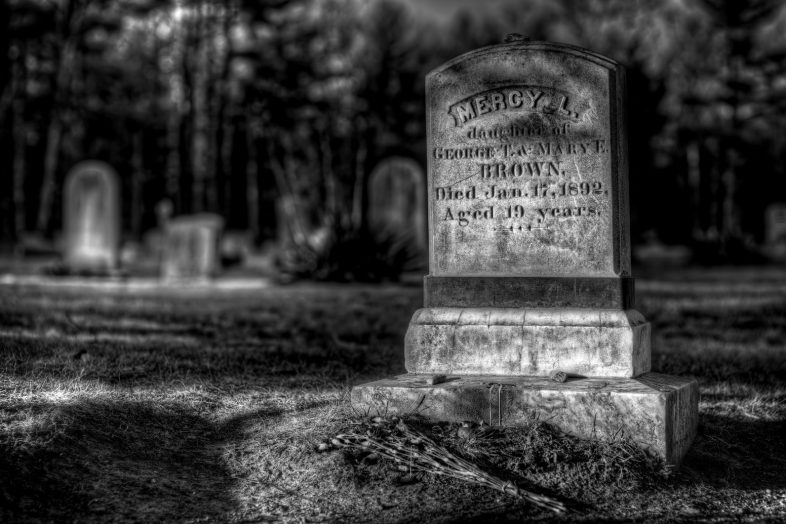
The Mercy Brown Vampire Incident: Unveiling New England’s Last Witch-Hunt
The Mercy Brown vampire incident is one of the most infamous and enduring stories of vampire folklore in American history. Taking place in late 19th-century Rhode Island, this strange and tragic event captures the fears and superstitions of a small rural community faced with a deadly and misunderstood disease—tuberculosis, or “consumption” as it was known at the time. The Mercy Brown case, though one of many similar stories from New England, stands out because it was one of the last instances in the United States where an alleged vampire exhumation occurred. It is a window into the beliefs, rituals, and fears that gripped communities long before medical science could provide answers. This article explores the background of the incident, the cultural and historical context, and how it came to symbolize the collision between folklore and science.
Historical Context: Tuberculosis and the Fear of Vampirism
In the 19th century, tuberculosis (TB) was a widespread and deadly disease that ravaged communities, particularly in New England. It is estimated that during this period, TB was responsible for the deaths of one in seven people. The disease spread rapidly, often affecting entire families. Its symptoms were terrifying: weight loss, a persistent cough that produced blood, pallor, and extreme fatigue. The death of one family member was frequently followed by the illness of others, leading many to believe that the dead were somehow feeding off the living.
At the time, medical knowledge about tuberculosis was limited. There was no clear understanding of how the disease spread or how it could be treated. In the absence of scientific explanations, people turned to folklore and superstition. One of the beliefs that took hold in rural areas of New England was that the dead could become vampires, draining the life from their surviving family members. The concept of the vampire in New England folklore was not the romanticized, sophisticated creature that we see in modern media, but rather a corpse that remained active in its grave, feeding on the life essence of its relatives.
This belief in vampires was fueled by a combination of old-world superstitions brought over by European immigrants and the fear and despair caused by the relentless spread of tuberculosis. Families suffering from multiple deaths were often left with few options but to believe that supernatural forces were at work. In these rural communities, the rituals to combat vampirism—exhuming bodies and burning hearts—became desperate acts of self-preservation.
The Brown Family and the Plague of Consumption
The Brown family, central to the Mercy Brown incident, lived in the rural village of Exeter, Rhode Island. George Brown, a farmer, and his family were typical of the tight-knit, agrarian communities in the region. However, like many families of the time, the Browns were devastated by tuberculosis. Between 1883 and 1892, George Brown lost his wife, Mary Eliza, and two of his daughters, Mary Olive and Mercy Lena Brown, to the disease. His only surviving son, Edwin, also contracted tuberculosis and was near death by the winter of 1891-92.
Mary Eliza, George’s wife, was the first to die of tuberculosis in 1883. A few years later, their daughter Mary Olive followed, succumbing to the disease in 1886. Mary Olive’s obituary mentioned her “youthful, innocent” appearance, and her funeral was a large event attended by many in the community, as she had been popular and well-liked. Her death marked the start of a growing fear that something sinister was at work within the family.
Following Mary Olive’s death, George’s son Edwin also fell ill. He traveled to Colorado in an attempt to recover, as the drier climate was thought to be beneficial for tuberculosis patients, but his condition worsened, and he returned home in the winter of 1891. Shortly after his return, George’s youngest daughter, Mercy Lena Brown, also became ill and died on January 17, 1892, at the age of 19.
By this point, George Brown was desperate. Having lost his wife and two daughters to the disease, and watching his only son slowly waste away, he was willing to consider any solution, no matter how unorthodox. Rumors began to circulate in the community that one of the deceased family members might be a vampire, responsible for draining the life from Edwin. These rumors were likely fueled by local superstitions and the desperate desire to save Edwin’s life.
The Exhumation and Ritual
In March of 1892, local residents and friends of George Brown persuaded him to allow the bodies of his deceased family members to be exhumed to check for signs of vampirism. The belief was that if one of the bodies showed signs of being undead—such as a lack of decomposition—it might be responsible for Edwin’s illness. The solution, according to folklore, would be to perform a ritual to destroy the vampire and stop it from harming the living.
On the morning of March 17, 1892, a small group of townspeople, along with Dr. Harold Metcalf, the family physician, gathered at the Chestnut Hill Cemetery in Exeter. The bodies of Mary Eliza and Mary Olive, who had been dead for several years, were exhumed and found to be in an advanced state of decomposition, which was expected. However, when they opened the grave of Mercy Brown, who had died just two months earlier, they found that her body was remarkably well-preserved, despite the cold winter.
Mercy’s preservation, though easily explained by modern science as a result of the freezing winter conditions, was seen as a sign of something unnatural. Further examination revealed that her body still had blood in the heart and liver. This was interpreted as evidence that Mercy was a vampire, feeding on her brother Edwin from beyond the grave.
At this point, a grim ritual was performed. Mercy’s heart and liver were removed from her body and burned on a nearby rock. The ashes of her heart were then mixed with water to create a tonic, which was given to Edwin to drink in the hope that it would cure him of the vampire’s influence. Despite the gruesome efforts, Edwin’s health continued to decline, and he died two months later, on May 2, 1892.
The Aftermath and Legacy
The Mercy Brown vampire incident quickly became a subject of interest beyond Exeter. The story was picked up by newspapers, both local and national, and soon spread across the United States. Some accounts were sensationalized, while others took a more critical view of the superstitious practices involved. The case even attracted the attention of renowned author Bram Stoker, who was working on his novel *Dracula* at the time. Some scholars believe that Mercy Brown may have influenced Stoker’s creation of Lucy Westenra, one of the vampire’s victims in the novel, although this remains speculative.
The incident marked one of the last instances of a vampire exhumation in New England. By the late 19th century, medical science was beginning to offer more explanations for tuberculosis, and belief in supernatural causes for disease was fading. However, the story of Mercy Brown endures as a symbol of the fear and superstition that gripped communities during this period.
Today, the Mercy Brown incident is often viewed through the lens of folklore and anthropology. It reflects the desperation of communities facing a deadly, incurable disease, and how folklore provided a framework for understanding the unknown. The belief in vampirism as a cause of tuberculosis may seem irrational to modern readers, but in the context of the time, it offered a means of explaining the unexplainable and a way to take action in the face of helplessness.
Vampirism in New England Folklore
The Mercy Brown incident was not an isolated case. Throughout the 18th and 19th centuries, rural communities in New England were plagued by tuberculosis, and many similar exhumations took place. These events were part of a larger tradition of vampire folklore in the region, which had its roots in European superstition.
The belief in vampires was brought to America by settlers from Europe, particularly from countries like Germany, where vampire legends were widespread. These legends often described the vampire as a revenant, a person who had died but returned from the grave to harm the living. In New England, the vampire became associated with the mysterious deaths caused by tuberculosis.
There were several key elements to New England vampire folklore. The first was the belief that a vampire was someone who had died of tuberculosis or another wasting disease. After their death, the vampire was thought to continue draining the life force from their surviving relatives, causing them to become ill and eventually die. The second element was the ritual of exhumation, in which the body of the suspected vampire was dug up and examined for signs of vampirism, such as a lack of decomposition or blood in the heart. If these signs were present, the heart would be removed and burned to stop the vampire from continuing its attacks.
One of the earliest recorded instances of a vampire exhumation in New England occurred in 1793, in the town of Willington, Connecticut. In that case, the body of a man named Isaac Johnson was exhumed after his family members began to die of tuberculosis. Johnson’s body was found to be in a preserved state, and his heart was removed and burned to stop the spread of the disease. Similar cases occurred throughout the region in the following decades, with exhumations taking place in towns like Woodstock, Vermont, and Jewett City, Connecticut.
While these events may seem bizarre and macabre today, they were driven by the desperate need to find some explanation for the mysterious deaths that plagued these communities. In an era before modern medicine, folklore and superstition offered a way to make sense of the seemingly supernatural forces at work.
Science vs. Superstition: The Role of Medicine
The Mercy Brown incident occurred at a time when scientific understanding of tuberculosis was beginning to emerge, but it had not yet reached the general public. In 1882, just a decade before Mercy’s death, German physician Robert Koch had identified the bacterium responsible for tuberculosis, which marked a major breakthrough in medical science. However, this discovery had not yet made its way to rural communities like Exeter, where people continued to rely on traditional beliefs to explain the disease.
One of the reasons that the belief in vampires persisted for so long in New England was that the symptoms of tuberculosis mimicked the signs of vampiric activity. The disease often struck families in succession, with one member falling ill after another. This created the impression that the dead were somehow draining the life from the living. The visible symptoms of tuberculosis—paleness, weight loss, and coughing up blood—further fueled the belief that the sick were being attacked by supernatural forces.
Medical science at the time was still in its infancy when it came to understanding infectious diseases. The germ theory of disease, which states that diseases are caused by microorganisms, was not widely accepted until the late 19th century. In the absence of this knowledge, people relied on more familiar explanations, such as vampirism, to make sense of the suffering around them.
In addition, the medical profession itself was often skeptical of these vampire rituals. Dr. Harold Metcalf, the physician present at Mercy Brown’s exhumation, reportedly tried to dissuade the townspeople from performing the ritual, explaining that there was no scientific basis for their beliefs. However, his objections were overruled by the community, demonstrating the power that folklore held over people’s understanding of illness and death.
The Enduring Legacy of Mercy Brown
Today, Mercy Brown’s grave in Chestnut Hill Cemetery is a popular destination for those interested in folklore and the supernatural. The incident has become a part of Rhode Island’s cultural history, and it is often referenced in discussions of American vampire lore. In addition to its influence on Bram Stoker’s *Dracula*, the Mercy Brown case has been featured in various books, documentaries, and television shows.
The story also serves as a reminder of how fear and superstition can shape human behavior, particularly in times of crisis. In the face of an unknown and deadly disease, the people of Exeter turned to their traditional beliefs, hoping that the old ways would offer a solution. Their actions, though extreme, were a reflection of the deep-seated anxieties that tuberculosis brought to communities throughout New England.
While the belief in vampires has long since faded, the Mercy Brown incident remains a powerful example of how folklore can intersect with history and medicine. It is a story of tragedy and desperation, but also of resilience in the face of overwhelming fear. Today, we can look back on this chapter of American history with a mixture of fascination and horror, understanding that while the people of Exeter may have been wrong in their beliefs, they were acting out of a desire to protect their loved ones in the only way they knew how.
The Mercy Brown vampire incident stands as a haunting reminder of a time when folklore and superstition dominated explanations of disease and death. In the face of tuberculosis—a disease that claimed countless lives—rural communities like Exeter turned to vampire rituals as a means of combatting what they could not understand. The story of Mercy Brown is emblematic of the larger folklore traditions in New England, where the fear of vampirism was deeply intertwined with the devastation caused by consumption. Today, the incident is both a curiosity of history and a poignant illustration of human fear, resilience, and the desperate search for answers in the face of incomprehensible tragedy.





Add Comment